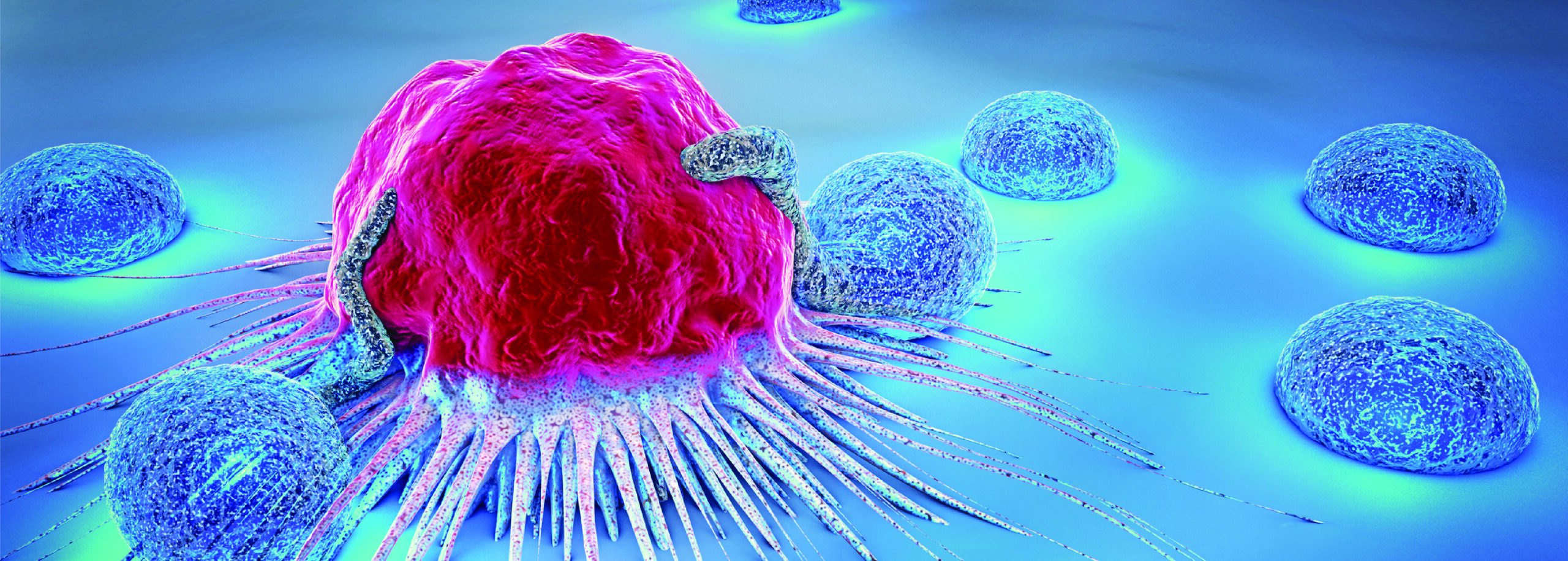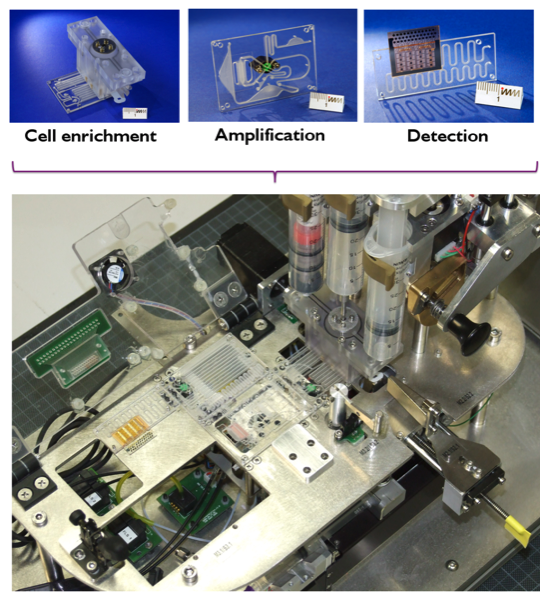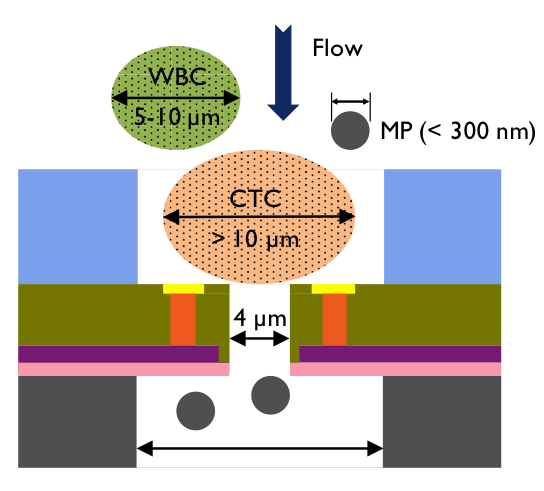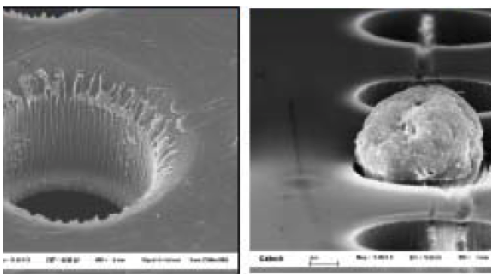ASIC development for next-generation Lab-on-Chip
 A lab-on-chip is a miniaturized device (typically only a few cm2 in size) that integrates one or multiple analyses onto a single chip. Such analyses are usually done in a clinical lab and are therefore time consuming. The most known types are DNA sequencing and biochemical detection. Miniaturization of biochemical operations has a lot of advantages, such as cost efficiency, automation, high-throughput screening and sensitivity. The current lab-on-chip developments mainly rely on two core technologies: microfluidics (the physics, manipulation and fluidic behavior) and molecular biology.
A lab-on-chip is a miniaturized device (typically only a few cm2 in size) that integrates one or multiple analyses onto a single chip. Such analyses are usually done in a clinical lab and are therefore time consuming. The most known types are DNA sequencing and biochemical detection. Miniaturization of biochemical operations has a lot of advantages, such as cost efficiency, automation, high-throughput screening and sensitivity. The current lab-on-chip developments mainly rely on two core technologies: microfluidics (the physics, manipulation and fluidic behavior) and molecular biology.
Lab-on-chip as enabler for high-throughput screening and faster genome sequencing
Microfluidic technologies used in lab-on-chip devices allow to manufacture millions of microchannels, each measuring a few micrometers, on a single chip that fits in your hand. The microchannels enable the handling of fluids in quantities as low as a few pico-liters as well as the manipulation of biochemical reactions at very small volumes.
The big advantage here is that you can complete microfluidic technologies with pumps and valves for transporting samples, incubator chambers for carrying out biochemical reactions, ultra-fast microscopes for viewing, microprocessors for data-processing, etc. All that encapsulated in one tiny device just a few cm² in size – and which is also cheap to produce that it can be used as a disposable test unit, comparable with a pregnancy test today.
Early microfluidic research focuses on the miniaturization of biochemical operations such as Polymerase Chain Reaction (PCR, a technology used to multiply DNA for pathogen detection) applications and other biochemical operations such as electrophoresis, DNA microarray, cell lysis, etc. Today, lab-on-chip not only shows the capacity of integration and parallelization, but also demonstrates superior performance compared to conventional technologies. The integration of PCR on a lab-on-chip allows DNA to be amplified more than ten times faster than with conventional technologies. By using a lab-on-chip device to integrate an array of DNA probes, we are able to sequence genomes thousands of times faster. Moreover, nanopore technologies, which are still in development, hold great potential in the future as a faster solution for genome sequencing.
Lab-on-chip for future cell biology diagnostics
Since microchannels are at the same typical size as cells, lab-on-chip devices enable the ability to control cells at the single-cell level, while dealing with large amounts of cells in a few seconds. In combination with faster optical detectors, one can detect a cancer cell at high throughput. There are several other applications for lab-on-chip in cell biology, including control of stem cell differentiation, high-speed flow cytometry and cell sorting.
Next generation lab-on-chip mems
ICsense has been working closely with other partners(1) on the development of a low-cost, fully automated, integrated lab-on-chip system for the isolation, counting and characterization of Circulating Tumor Cells (CTC) in clinical blood samples. These circulating tumor cells, not detectable by current routine diagnostics, are a good indication if the primary tumor cells are disseminated to other parts of the body.
In contrast to standard phenotyping tests, we developed a fully automated and integrated microsystem that captures and characterizes tumor cells and includes the 1) enrichment, 2) an active sieve for cell sorting, electrochemical characterization and lysis, and 3) genotyping of the leukocytes cells. The inclusion of active electrodes in the pores of the active sieve enables the characterization and the counting of the isolated cells based on electrical cell impedance spectroscopy (EIS). This non-invasive method provides cell information through permittivity and conductivity measurements of the cell membrane.
Specifically for the active sieve cell sorting, ICsense designed the impedance spectroscopy measurement, the DEP (electrophoresis) control, the signal processing and analog-to-digital conversion that enables the electrical identification of individual cancer cells in a 100 x 100 cell/pore matrix.
The specialized interface ASIC developed by ICsense can measure individual cell membrane impedances over a frequency range from 10kHz to 1MHz with an accuracy better than 1 fF/µm2. Consider that this is 100 times smaller than the typical parasitic impedance of an ASIC and you’ll understand the complexity of this measurement task. ICsense’s ASIC captures data from a matrix of 100×100 cells that, in full speed scan mode, can be read out in 250 µs.
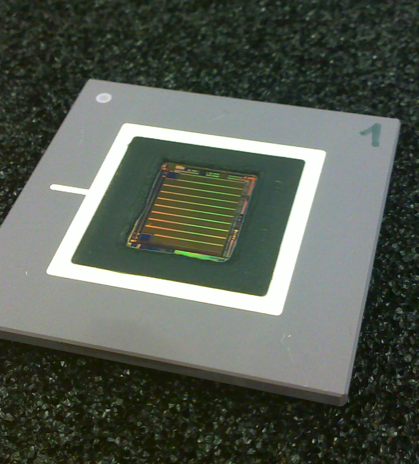
ASIC to capture data from a matrix of 100×100 cells that, in full speed scan mode, can be read out in 250 µs.
Why choose ICsense for your lab-on-chip development ?
ICsense is ISO13485 certified for medical ASIC developments. Since 2004, the mixed-signal ASICs of ICsense are used in implantable class III medical devices, ultra-low-power devices with high sensing accuracy, hearing aid devices and wearables/portables for world-class medical device manufacturers. Through its systematic and certified development process, ICsense can ensure the quality, safety and long-term reliability for medical ASICs.
Why choose ICsense ?
- In-house proven topologies for highest efficiency and ultra low-power (uW) sensing performance
- Over 15 years of expertise in highly accurate sensor read-outs and lab-on-chip interfacing
- ISO13485 certified for medical IC designs (implants + external)
- Largest design team in Europe for on-time project delivery
Reach out to our team using the online contact form or write us an email at sales@icsense.com
(1) FP7 project, MIRACLE. https://miracle.consultech.de/project/partners/icsense/page27.html
